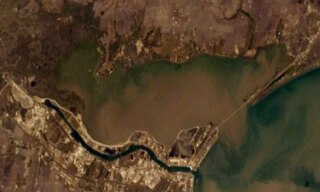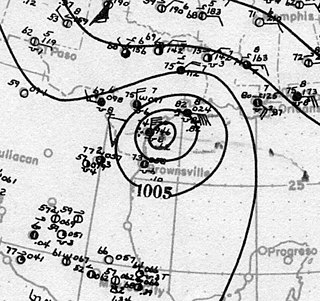
Corpus Christi is a coastal city in the South Texas region of the U.S. state of Texas and the county seat and largest city of Nueces County. Portions of the city also extend into Aransas, Kleberg, and San Patricio counties. It is 130 miles (210 km) southeast of San Antonio and 208 miles (335 km) southwest of Houston. Its political boundaries encompass Nueces Bay and Corpus Christi Bay. Its zoned boundaries include small land parcels or water inlets of three neighboring counties.

KZTV is a television station in Corpus Christi, Texas, United States, affiliated with CBS. It is owned by SagamoreHill Broadcasting, which maintains a shared services agreement (SSA) with the E. W. Scripps Company, owner of dual NBC/CW+ affiliate KRIS-TV and low-power dual Telemundo affiliate/independent station K22JA-D, for the provision of certain services. The stations share studios on Artesian Street in downtown Corpus Christi; KZTV's transmitter is located between Petronila and Robstown.

Harry Milner Whittington was an American lawyer, real estate investor, and political figure. He received international media attention following an incident on February 11, 2006, when he was accidentally shot in the face, neck, and torso by then-United States vice president Dick Cheney while hunting quail with two women on a ranch in Kenedy County, Texas, near Corpus Christi. It was the first time someone had been shot by a sitting vice-president since Alexander Hamilton was shot in a duel by Aaron Burr in 1804.
CHRISTUS Spohn Hospital Corpus Christi - Memorial was a 465-bed hospital in Corpus Christi, Texas that was part of the CHRISTUS Spohn Health System, operated by CHRISTUS Health. It ceased all operations in September 2022, and was demolished in April 2023.
On February 11, 2006, then-United States vice president Dick Cheney shot Harry Whittington, a then-78-year-old Texas attorney, with a 28-gauge Perazzi shotgun while participating in a quail hunt on a ranch in Riviera, Texas. Both Cheney and Whittington called the incident an accident.

Corpus Christi Bay is a scenic semi-tropical bay on the Texas coast found in San Patricio and Nueces counties, next to the major city of Corpus Christi. It is separated from the Gulf of Mexico by Mustang Island, and is fed by the Nueces River and Oso Creek from its western and southern extensions, Nueces Bay and Oso Bay. The bay is located approximately 136 miles (219 km) south of San Antonio, and 179 miles (288 km) southwest of Houston.

KTOV-LP was a low-power analog television station in Corpus Christi, Texas, United States, which operated from 2002 to 2018. Last owned by Sinclair Broadcast Group, its final programming was MyNetworkTV. It was functionally replaced by a digital subchannel of co-owned Fox affiliate KSCC. The transmitter was located on Leopard Street in Corpus Christi. The "My KTOV" branding is still used on the subchannel.

K22JA-D is a low-power television station in Corpus Christi, Texas, United States. It is owned by the E. W. Scripps Company alongside NBC affiliate KRIS-TV ; Scripps also provides certain services to CBS affiliate KZTV under a shared services agreement (SSA) with SagamoreHill Broadcasting. The stations share studios on Artesian Street in downtown Corpus Christi, where K22JA-D's transmitter is also located.

KIII is a television station in Corpus Christi, Texas, United States, affiliated with ABC and owned by Tegna Inc. The station's studios are located on South Padre Island Drive in Corpus Christi, and its transmitter is located near Robstown, Texas.
KORO is a television station in Corpus Christi, Texas, United States, affiliated with the Spanish-language network Univision. It is owned by Entravision Communications alongside low-power, Class A UniMás affiliate KCRP-CD. The two stations share studios on North Mesquite Street in downtown Corpus Christi; KORO's transmitter is located between Petronila and Robstown.
KXPX-LP was a low-power analog television station in Corpus Christi, Texas, United States, which operated from 1991 to 2018. Last owned by Sinclair Broadcast Group, its final programming was the digital multicast network TBD. It was functionally replaced by a digital subchannel of co-owned Fox affiliate KSCC. The transmitter was located on Leopard Street in Corpus Christi.
Old Bayview Cemetery is a cemetery located on a small hill in downtown Corpus Christi, Texas on Ramirez St. at Padre St., bordered by the I-37 access road. It is the oldest federal military cemetery in Texas. Owned by the City of Corpus Christi, it presently comprises three and a half acres as a Historic Texas Cemetery and a State Archaeological Landmark of the Texas Historical Commission. The cemetery was listed on the National Register of Historic Places in 2020.

Nueces Bay is a northwestern extension of Corpus Christi Bay in the San Patricio and Nueces Counties of Texas. The bay is fed by the Nueces River, forming a natural estuary, which renders it ecologically and economically vital to the surrounding area. It serves as a habitat for the propagation of fish and shellfish, which sustain diverse species of birds and other wildlife. The bay is threatened by pollution from the heavy industry on its southern shore, which prevents oyster farming. Petrochemical production and oil are important to the surrounding economies of the major settlements of Corpus Christi and Portland, found on the eastern shore and connected by the Nueces Bay Causeway at the bay's confluence with Corpus Christi Bay.

Corpus Christi is a coastal city in the South Texas region of the U.S. state of Texas. The county seat of Nueces County, it also extends into Aransas, Kleberg, and San Patricio counties. The population was 277,454 at the 2000 census; in 2006 the U.S. Census Bureau estimated the city's population at 285,175, making it the eighth-largest city in the state. It is the principal city of the three-county Corpus Christi Metropolitan Statistical Area as well as the larger Corpus Christi-Kingsville Combined Statistical Area. The translation from Latin of the city's name is Body of Christ, given to the settlement by the Spanish, in honor of the Blessed Sacrament (Eucharist). The city has been nicknamed The Sparkling City by the Sea, or "Corpitos" particularly in literature promoting tourism.

Redfish Bay is a southwestern extension of Aransas Bay in Texas, north of Corpus Christi Bay. It separates the cities of Aransas Pass and Ingleside from Port Aransas on Mustang Island.
Edward Holmead Harte was an American newspaper executive, journalist, philanthropist, and conservationist. The son of Houston Harte, co-founder of the Harte-Hanks newspaper conglomerate, he had a decades-long relationship with that organization. For Harte-Hanks, he was an executive and journalist with various newspapers, including The Snyder Daily News, The San Angelo Standard-Times, and The Corpus Christi Caller-Times. He also served as vice chairman of Harte-Hanks from 1962 to 1987. As a philanthropist, he donated tens of millions of dollars to a variety of charities and institutions. He was also a pioneer in environmental conservationism in Texas, notably spearheading successful land conservation campaigns on Padre Island and Mustang Island. In 2002, the National Audubon Society awarded him the Audubon Medal.
The Port of Corpus Christi is the largest port in the United States in total revenue tonnage, third largest in total waterway tonnage, and the largest crude oil export gateway in the nation. The Port of Corpus Christi is located on Corpus Christi Bay in the western Gulf of Mexico, with a 36-mile channel that is being widened and deepened to 54 feet MLLW from its current depth of 45 feet.
Henry Pomeroy "Roy" Miller, once the "boy mayor of Corpus Christi", was a Texas newspaperman, politician, and lobbyist influential in both the state capital Austin and national capital Washington, D.C. He represented sulphur interests in Texas.
The following is a timeline of the history of the city of Corpus Christi, Texas, USA.

The effects of the 1919 Florida Keys hurricane in Texas were the deadliest of any tropical cyclone in the Texas Coastal Bend, killing at least 284 people. The hurricane produced a widespread swath of devastation across the region, exacerbated by the large extent of its winds. The city of Corpus Christi bore the brunt of the hurricane's impacts, contributing to the largest portion of the damage toll in Texas; nearly all of the confirmed fatalities were residents of the city. The storm originated from the Leeward Islands early in September 1919 and took a generally west-northwestward course, devastating the Florida Keys en route to the Gulf of Mexico. On the afternoon of September 14, the center of the hurricane made landfall upon the Texas coast at Baffin Bay. The storm's winds were estimated at 115 mph (185 km/h) at landfall, making it a Category 3 hurricane on the Saffir–Simpson hurricane wind scale. After slowly moving ashore, it weakened and straddled the Rio Grande before dissipating on September 16 over West Texas.









